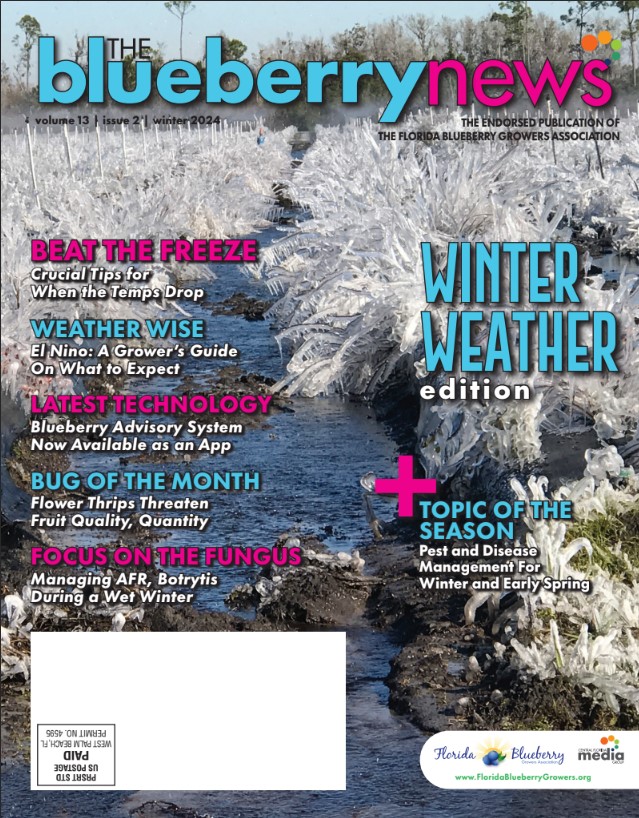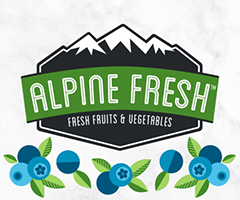The table below lists suggested blueberry management items for spring and early summer. Suggested management items for the entire calendar year are available in an EDIS publication, Calendar for Southern Highbush Blueberry Management in Florida (https://edis.ifas.ufl.edu/publication/HS1363). Specific disease, insect, and weed controls are listed in the 2022 Florida Blueberry IPM Guide (https://edis.ifas.ufl.edu/publication/HS380), as well as in subject-specific publications referenced below. Also, a list of all UF EDIS blueberry publications can be found at www.blueberrybreeding.com/blog, along with a summary description and link to each.
Remember to take a look at the UF/IFAS Blueberry Growers Guide phone app (available in both English and Spanish) for field scouting tools, information on all of the UF southern highbush blueberry cultivars, and a new quick reference guide for pesticides (available for download at https://tosto.re/blueberryuf).
CREDIT
Doug Phillips
UF Blueberry Extension Coordinator
April
|
Disease |
Apply suggested fungicides in rotation for control of anthracnose and/or Alternaria fruit rot; promptly harvest and cool ripe fruit. One tool growers may consider in timing spray applications is the Blueberry Advisory System (BAS) at www.agroclimate.org/BAS, which indicates when weather conditions are favorable for the development of anthracnose fruit rot. |
|
Insect Pests |
Monitor for gall midge and flower thrips and control as needed. Spray suggested insecticides to control spotted wing drosophila (SWD), and promptly harvest ripe fruit. If living north of Lake City and there is a history of blueberry maggot, establish yellow sticky traps to monitor for blueberry maggot adults. Also, in infested areas, start scouting for adult Diaprepes (citrus) root weevils, and adult flatheaded borers on the blueberry foliage. No pesticide is labeled in blueberry for citrus root weevil and flatheaded borer; however, some of the cover sprays for spotted wing drosophila will control these pests. See UF EDIS Publication ENY999, Diaprepes Root Weevil on Southern Highbush Blueberry in Florida (https://edis.ifas.ufl.edu/publication/IN1241). Post-harvest, spray to control blueberry bud mite if present or observed in prior season. |
|
Weeds |
Apply post-emergence herbicide if weeds are at densities that hinder bush growth. |
May
|
Disease |
Monitor for post-harvest leaf diseases (rust, anthracnose, Septoria, target spot, Phyllosticta) and apply suggested control measures. See UF EDIS Publication PP348, FloridaBlueberry Leaf Disease Guide (https://edis.ifas.ufl.edu/publication/PP348). |
|
Insect Pests |
Continue with insecticide sprays for spotted wing drosophila for the remaining ripe fruit that is left on the bush. Continue monitoring for blueberry maggot in affected areas. Continue monitoring for adult citrus root weevils and adult flatheaded borers in infested areas. See UF EDIS Publication ENY999, Diaprepes Root Weevil on Southern Highbush Blueberry in Florida (https://edis.ifas.ufl.edu/publication/IN1241). Post-harvest, spray to control blueberry bud mite if present or observed in prior season. Scout for chilli thrips (leaf curling and bronzing) and blueberry flea (leaf) beetle (shot holes in the leaf) and apply suggested control measures if present. See UF EDIS Publication EENY2053, Chilli thrips on Blueberries in Florida (https://edis.ifas.ufl.edu/publication/IN1298). |
|
Weeds |
Apply a pre-emergence herbicide after harvest (tank mix with a post-emergence herbicide if weeds are at densities that hinder bush growth). |
|
Pruning |
After harvest is complete, hedge back bushes to stimulate new vegetative growth, immediately spraying with a suggested fungicide to minimize the risk of fungal pathogens infecting through pruning wounds. See UF EDIS Publication HS1359, Pruning Southern Highbush Blueberry in Florida (https://edis.ifas.ufl.edu/publication/HS1359). |
June
|
Disease |
Scout for algal stem blotch. See UF EDIS Publication PP344, Algal Stem Blotch in Southern Highbush Blueberry in Florida (https://edis.ifas.ufl.edu/publication/PP344). Selectively prune out canes infected with algal stem blotch, Botryosphaeria stem blight, and dead canes. Monitor and manage leaf diseases. See UF EDIS Publication PP348, Florida Blueberry Leaf Disease Guide (https://edis.ifas.ufl.edu/publication/PP348). Apply Ridomil to help prevent Phytophthora root rot. On farms managing bacterial wilt, begin monthly through-irrigation or banded bed applications of a phosphorous acid product. See UF EDIS Publication PP332, Bacterial Wilt of Southern Highbush Blueberry Caused by Ralstonia solanacearum (https://edis.ifas.ufl.edu/publication/PP332). |
|
Insect Pests |
Scout for flea beetles, larval citrus root weevil (by pulling out dead or dying plants and examining the roots and surrounding soil/bark), larval flatheaded borer, chilli thrips, and southern red mites and apply suggested control measures if present. See UF EDIS Publications ENY999, Diaprepes Root Weevil on Southern Highbush Blueberry in Florida (https://edis.ifas.ufl.edu/publication/IN1241), EENY2053, Chilli thrips on Blueberries in Florida (https://edis.ifas.ufl.edu/publication/IN1298), and ENY1006, Mite Pests of Southern Highbush Blueberry in Florida (https://edis.ifas.ufl.edu/publication/IN1284). |
|
Leaf Tissue Samples |
Leaves should be collected for tissue nutrient analysis. Select samples from fully expanded leaves in the middle of a recent summer growth flush. |
|
Weeds |
Apply post-emergence herbicide if weeds are at densities that hinder bush growth. |





